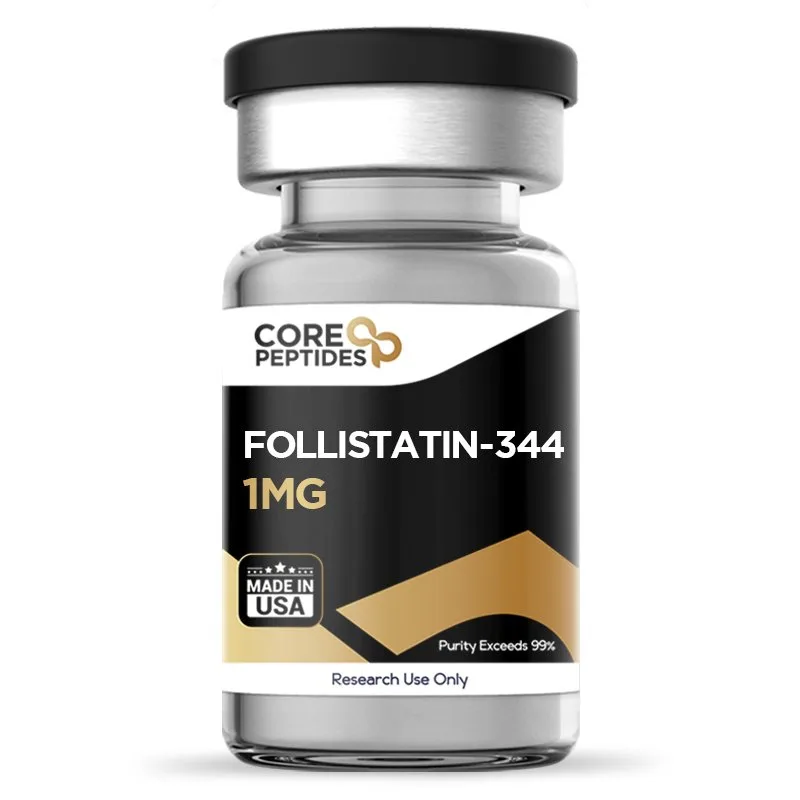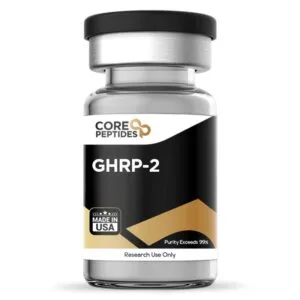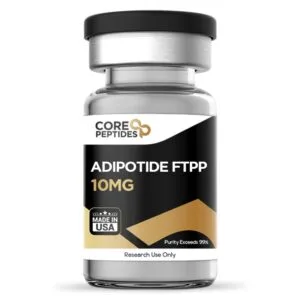Follistatin-344 (1mg)
$138.00
Size: 1mg
Contents: Follistatin-344 (1mg)
Form: Lyophilized powder
Purity: >99%
SKU: P-FOLLISTN-1
FREE Shipping on $200+ orders
Discount per Quantity
| Quantity | Discount | Price |
|---|---|---|
| 5 - 8 | 5% | $131.10 |
| 9 + | 10% | $124.20 |
Follistatin-344 Peptide
Follistatin-344 is a naturally occurring glycoprotein that is considered to be present in almost all tissues. It is considered an autocrine chemical, meaning that the cell produces a chemical messenger through a cell signal, which binds to its autocrine receptors, resulting in cell modification.(1) Follistatin naturally occurs in two isoforms, FST 317 and FST 344, each containing 288 and 315 amino acids, respectively. These two isoforms may be produced through an alternative splicing process of the mRNA.(2) Their names are based on the parent molecules from which they are derived and contain 317 and 344 amino acids, respectively. Follistatin-344 is considered to be the predominantly expressed molecule in most tissues, while the Follistatin-317 isoform may account for less than 5% of the encoded mRNA.
Follistatin-344 is a synthetic version of the endogenous Follistatin-344 protein isoform. Although the number of amino acids differs in Follistatin isoforms, at its core, the protein comprises 63 amino acid residues and three domains: FSD1, FSD2, and FSD3, with an identical structure in the synthetic peptide.(3) These domains comprise 73-77 amino acid residues and are characterized by 10 conserved cysteine residues.
Overview
Researchers posit that Follistatin's primary potential may exist in activin-binding action.(4) Follistatin has been suggested to have a collaborative role in reproductive functioning alongside other chemicals like activin and inhibins. Scientists posit that the ovarian follicle mainly releases activin to enhance the secretion of follicle-stimulating hormone. Follistatin may bind with activin and attenuate its action by inhibiting the secretion of the FSH hormone.
While the origin and mechanism of the peptide hormone are not entirely understood, it has been suggested that Follistatin-344 is locally produced in the pituitary gland, gonads, testes, and ovaries. Additionally, Follistatin may be vastly distributed in various organs and potentially may be present in blood circulation due to its secretion from the blood vessels.
Further, Follistatin-344 is hypothesized to interact with various proteins within the Transforming Growth Factor-beta (TGFβ) superfamily.(16) This superfamily includes several key regulatory proteins in cellular growth and differentiation. One potential interaction is with the Bone Morphogenetic Proteins (BMPs), which are believed to play roles in bone formation, embryonic development, and cellular growth. It is conjectured that Follistatin-344 might modulate the activity of certain BMPs, though the specific proteins and mechanisms remain uncertain and require further exploration. Another possible interaction involves Growth Differentiation Factor 9 (GDF9), crucial for ovarian follicle development in female organisms. The binding of Follistatin-344 to GDF9 may suggest a regulatory role in reproductive processes, but this interaction is not fully understood and is subject to ongoing research.
However, the most notable of these interactions is with Growth Differentiation Factor 8 (GDF8), commonly known as myostatin. Myostatin is deemed integral to controlling muscle cell growth and differentiation, acting as a natural inhibitor to prevent excessive muscle development. It is proposed that Follistatin-344 binds to myostatin, potentially inhibiting its function. This inhibition may theoretically facilitate an increase in muscle mass by allowing muscle cells greater freedom to grow and differentiate. The potential for Follistatin-344 to enhance muscle growth through myostatin inhibition presents a significant area of interest, although the actual outcomes may vary and are highly dependent on singular biological conditions.
Chemical Makeup
Molecular Formula: N/A
Molecular Weight: 3780 g/mol
Other Known Titles: Activin-Binding Protein, FSH-Suppressing Protein, FST
Research and Clinical Studies
Follistatin-344 and Muscle Development
Myostatin is a protein considered to be synthesized by muscle cells, hindering muscle cell differentiation and growth. As mentioned, myostatin protein belongs to the transforming growth factor-beta (TGF-beta) protein, which Follistatin may inhibit. During one 1997 study,(5) it was suggested that mice given Follistatin-344 exhibited reduced levels of myostatin, which might have led to the improved skeletal muscle mass with each mouse weighing 2 to 3 times more than usual, and the increase in mass appeared to result from a combination of muscle cell hyperplasia and hypertrophy.
In another study,(6) Follistatin-344 was induced in mice via a nanoparticle-mediated mode of delivery of mRNA in the liver. The researchers reported that the mRNA messenger appeared to stimulate the hepatic liver cells to naturally synthesize and secrete Follistatin. Results of this study suggested that the peptide mice, given this mRNA-containing nanoparticle, exhibited apparently increased serum levels of Follistatin within three days as compared to the levels in control mice.
The research posits that Follistatin mRNA is translated in the liver, leading to increased serum levels of Follistatin. This elevation in Follistatin was suggested to persist for up to 72 hours post-presentation and was associated with decreased serum concentrations of myostatin and activin A. Activin A is a protein considered to be involved in a myriad of biological processes. It is a member of the transforming growth factor-beta (TGF-β) superfamily. It appears to play significant roles in regulating various cellular functions such as proliferation, differentiation, and apoptosis in numerous cell types. In the context of muscle physiology, activin A is particularly noteworthy for its role in muscle metabolism and remodeling. It is thought to be a critical regulator of muscle mass, as it appears to negatively influence muscle growth by promoting catabolic pathways that lead to muscle atrophy. This action is mediated primarily through its interaction with the activin type IIB receptor (ActRIIB) on muscle cells. Upon binding to this receptor, activin A activates intracellular signaling pathways that increase muscle protein breakdown and inhibit muscle protein synthesis. After 8 weeks of continuous peptide presentation, the lean muscle mass of the peptide mice was reportedly 10% more than the control mice.
In contrast to experiments targeting myostatin—such as anti-myostatin antibodies—Follistatin offers a broader research approach by also antagonizing activin A. Myostatin-specific experiments primarily focus on inhibiting pathways that directly limit muscle growth, thus promoting hypertrophy. However, they might not address other pathways that contribute to muscle loss, such as fibrosis or inflammation, which are influenced by activin A. Follistatin’s dual antagonistic action might lead to more comprehensive impact in muscle dystrophy models. By inhibiting both myostatin and activin A, Follistatin may not only enhance muscle mass but also reduce muscle stiffness and weakness associated with fibrotic changes. This potential dual action is particularly advantageous because it may address both the loss of muscle mass and the quality of the remaining muscle tissue, potentially leading to improvements in muscle function and strength that surpass those achieved by solely blocking myostatin.(7)
Follistatin-344 and Carcinogenic Cells
Breast Cancer Cells
Through reverse transcription polymerase chain reaction study (RT-PCR), researchers suggested that Follistatin levels may fluctuate in animal models of breast cancer.(8) One study(9) examined the available gene expression data of mice with breast cancer. In most cases, Follistatin was reportedly under-expressed in carcinogenic breast cells, possibly leading to the increased spread of cancer cells caused by activin proteins. As Follistatin is suggested to bind to and inhibit activin proteins, it was further posited by the researchers that restoring Follistatin in these mice might prevent the prognosis of activin-induced metastasis and improve overall survival.
Esophageal Cancer Cells
Research suggests that bone morphogenic protein (BMP) is one of the causative factors in the transition of normal esophageal tissue to cancerous tissues. Follistatin, speculated to host the capacity to bind and neutralize activin and myostatin, may also interact with BMPs. By modulating the activity of BMP, Follistatin may serve a protective role against the over-proliferation of cellular pathways often seen in cancerous tissues. Experimental studies in Follistatin-344 suggest that the peptide may counteract acid reflux actions, thereby possibly preventing an over-activation of BMP and the development of esophageal cancer cells. More specifically, Follistatin's potential to inhibit BMP might theoretically prevent the initial steps required for the transformation of normal tissue into cancerous tissue, particularly in environments exacerbated by chronic inflammation or external insults like acid reflux.(10)
Follistatin-344 and Cell Proliferation
There is an odd contrast in the working of Follistatin: it may potentially inhibit metastasis, as well as possibly promote cell proliferation. This is why the peptide is researched in studies scrutinizing increased tumor growth (tumorigenesis) and metastasis.(12) Research has suggested that hepatocytes (i.e., liver cells) may require Follistatin to proliferate. When studied in experimental rats, it was reported by the researchers that the inactivation of activin by Follistatin-344 may be a precondition for cell proliferation to occur. They believed there might be some energy exchange amongst the cells where the energy used for cell migration is shut off to switch with cellular growth and proliferation.
Follistatin-344 and Liver Protection
One study(13) was conducted to determine the potential of Follistatin on early liver fibrosis. In this study, rats were divided into one control group and one Follistatin-exposed group for a period of four weeks. Researchers reported that the peptide group showed a 32% decrease in liver fibrosis compared to the control group. They further reported that hepatocytic apoptosis was decreased by almost 90% in the Follistatin mice.
Follistatin-344 and Follicle Growth
Follistatin may exhibit wound healing potential via possible stimulation of interfollicular stem cells, which may lead to increased hair growth. A clinical study was conducted where the potential of this synthetic protein formulation, Hair Stimulating Complex (HSC), was studied in subjects with hair loss.(14) A cohort of 26 subjects were presented with the peptide for a period of 52 weeks. Histopathological evaluation of the tissues reportedly showed improved hair growth after 52 weeks compared to the control group. Besides hair growth, researchers reported an apparent improvement in hair thickness and density by almost 13%.
Follistatin-344 and Diabetic Mice Models
Researchers suggested that when Follistatin-344 was presented to diabetic murine models, it appeared to lead to overexpression of the protein in the pancreatic cells, resulting in increased pancreatic beta cell (β-cell) mass, reduced glucose level, and overall reduction in diabetic symptoms.(15) β-cells are a population of cells in the pancreas primarily tasked with producing insulin to lower glucose levels. The data suggest that this β-cell proliferation is possibly due to the inhibition of SMAD2/3 signaling, a pathway typically activated by transforming growth factor-beta (TGF-β) superfamily members such as activin and myostatin, which are believed to be antagonized by Follistatin. This inhibition might indirectly activate the insulin-phosphoinositide 3-kinase (PI3K)-Akt pathway, posited as crucial for cell growth and survival, potentially contributing to increased β-cell mass and improved glucose homeostasis. The researcher’s comments suggest that β-cell specific overexpression of Follistatin may lead to several notable outcomes in the tested db/db mice: a substantial increase in pancreatic islet mass, enhanced β-cell proliferation indicated by co-immunofluorescent staining for Ki67 and insulin, and improved overall metabolic profiles including reduced hyperglycemia.
It is also noted that these actions were accompanied by changes in insulin signaling within the pancreas, as detailed by elevated insulin levels and enhanced activation of the insulin-PI3K-Akt signaling pathway. Moreover, the study posits that Follistatin may influence the expression of other regulatory proteins and genes within the pancreas. For instance, the increased mRNA levels of myostatin and activin, along with their inhibitors BAMBI and inhibin-α, suggest a complex interplay where Follistatin may act to modulate these signaling molecules, possibly leading to an enhanced β-cell proliferative environment.
Additionally, the study explores the potential modulation of betatrophin, a hormone implicated in β-cell proliferation. The researchers observed a significant increase in betatrophin expression in the Follistatin groups, which might be facilitated by the suppressed activity of activin and myostatin due to Follistatin action. This suggests that Follistatin may be enhancing β-cell proliferation not only through direct inhibition of negative growth regulators but also by promoting positive growth signals such as betatrophin.
Follistatin-344 peptide is available for research and laboratory purposes only. Please review and adhere to our Terms and Conditions before ordering.
References:
- Hiroyuki Kaneko, Handbook of Hormones, 2016.
- FST follistatin [Homo sapiens (human)]. https://www.ncbi.nlm.nih.gov/gene?Db=gene&Cmd=DetailsSearch&Term=10468
- Shi, L., Resaul, J., Owen, S., Ye, L., & Jiang, W. G. (2016). Clinical and Therapeutic Implications of Follistatin in Solid Tumours. Cancer genomics & proteomics, 13(6), 425–435. https://www.ncbi.nlm.nih.gov/pmc/articles/PMC5219916/
- Rodino-Klapac, L. R., Haidet, A. M., Kota, J., Handy, C., Kaspar, B. K., & Mendell, J. R. (2009). Inhibition of myostatin with emphasis on follistatin as a therapy for muscle disease. Muscle & nerve, 39(3), 283–296. https://www.ncbi.nlm.nih.gov/pmc/articles/PMC2717722/
- McPherron AC, Lawler AM, Lee SJ. Regulation of skeletal muscle mass in mice by a new TGF-beta superfamily member. Nature. 1997 May 1;387(6628):83-90. https://pubmed.ncbi.nlm.nih.gov/9139826/
- Schumann C, Nguyen DX, Norgard M, Bortnyak Y, Korzun T, Chan S, Lorenz AS, Moses AS, Albarqi HA, Wong L, Michaelis K, Zhu X, Alani AWG, Taratula OR, Krasnow S, Marks DL, Taratula O. Increasing lean muscle mass in mice via nanoparticle-mediated hepatic delivery of follistatin mRNA. Theranostics 2018; 8(19):5276-5288. doi:10.7150/thno.27847. https://www.thno.org/v08p5276.htm
- Iskenderian A, Liu N, Deng Q, Huang Y, Shen C, Palmieri K, Crooker R, Lundberg D, Kastrapeli N, Pescatore B, Romashko A, Dumas J, Comeau R, Norton A, Pan J, Rong H, Derakhchan K, Ehmann DE. Myostatin and activin blockade by engineered follistatin results in hypertrophy and improves dystrophic pathology in mdx mouse more than myostatin blockade alone. Skelet Muscle. 2018 Oct 27;8(1):34. https://pubmed.ncbi.nlm.nih.gov/30368252/
- Zabkiewicz C, Resaul J, Hargest R, Jiang WG, Ye L. Increased Expression of Follistatin in Breast Cancer Reduces Invasiveness and Clinically Correlates with Better Survival. Cancer Genomics Proteomics. 2017 Jul-Aug;14(4):241-251. https://pubmed.ncbi.nlm.nih.gov/28647698/
- Seachrist DD, Sizemore ST, Johnson E, Abdul-Karim FW, Weber Bonk KL, Keri RA. Follistatin is a metastasis suppressor in a mouse model of HER2-positive breast cancer. Breast Cancer Res. 2017 Jun 5;19(1):66. target="_blank" rel="noopener"https://pubmed.ncbi.nlm.nih.gov/28583174/
- Lau MC, Ng KY, Wong TL, Tong M, Lee TK, Ming XY, Law S, Lee NP, Cheung AL, Qin YR, Chan KW, Ning W, Guan XY, Ma S. FSTL1 Promotes Metastasis and Chemoresistance in Esophageal Squamous Cell Carcinoma through NFκB-BMP Signaling Cross-talk. Cancer Res. 2017 Nov 1. https://pubmed.ncbi.nlm.nih.gov/28883005/
- Shi L, Resaul J, Owen S, Ye L, Jiang WG. Clinical and Therapeutic Implications of Follistatin in Solid Tumours. Cancer Genomics Proteomics. 2016 11-12;13(6):425-435. https://pubmed.ncbi.nlm.nih.gov/27807065/
- Ooe H, Chen Q, Kon J, Sasaki K, Miyoshi H, Ichinohe N, Tanimizu N, Mitaka T. Proliferation of rat small hepatocytes requires follistatin expression. J Cell Physiol. 2012 Jun;227(6):2363-70. https://pubmed.ncbi.nlm.nih.gov/21826650/
- Patella S, Phillips DJ, Tchongue J, de Kretser DM, Sievert W. Follistatin attenuates early liver fibrosis: effects on hepatic stellate cell activation and hepatocyte apoptosis. Am J Physiol Gastrointest Liver Physiol. 2006 Jan;290(1):G137-44. https://pubmed.ncbi.nlm.nih.gov/16123203/
- Zimber MP, Ziering C, Zeigler F, Hubka M, Mansbridge JN, Baumgartner M, Hubka K, Kellar R, Perez-Meza D, Sadick N, Naughton GK. Hair regrowth following a Wnt- and follistatin containing treatment: safety and efficacy in a first-in-man phase 1 clinical trial. J Drugs Dermatol. 2011 Nov;10(11):1308-12. https://pubmed.ncbi.nlm.nih.gov/22052313/
- Zhao C, Qiao C, Tang RH, Jiang J, Li J, Martin CB, Bulaklak K, Li J, Wang DW, Xiao X. Overcoming Insulin Insufficiency by Forced Follistatin Expression in β-cells of db/db Mice. Mol Ther. 2015 May;23(5):866-874. doi: 10.1038/mt.2015.29. Epub 2015 Feb 13. PMID: 25676679; PMCID: PMC4427879. https://pubmed.ncbi.nlm.nih.gov/25676679/
- Reichel C, Gmeiner G, Thevis M. Detection of black market follistatin 344. Drug Test Anal. 2019 Nov;11(11-12):1675-1697. doi: 10.1002/dta.2741. Erratum in: Drug Test Anal. 2020 Oct;12(10):1522-1533. PMID: 31758732.






